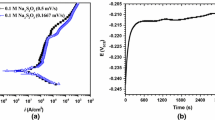Abstract
The release of nickel and chromium from stainless steels by sweat, is often responsible for allergic contact dermatitis. The amounts of metal released from stainless steels were in trace amounts, because corrosion resistance was excellent. However, measurement of dissolution amounts is difficult, and if these amounts are not known, the improvement and development of stainless steels with excellent resistance to NaCl solution is difficult. In this work, trace dissolution amounts from the main components of stainless steels which can cause an allergy were investigated. SUS 304, 316 and 444 stainless steels were used in this test. The test solutions used were 0.9 (isotonic sodium chloride solution), 1, 3, 5 and 10 wt% NaCl solutions. Nickel,chromium and iron ions in the test solutions were rapidly determined by stripping voltammetry. The detection limits of Ni(II), Cr(VI) and Fe(III) ions in 1 wt% NaCl solution were 1.0, 0.1 and 0.5 ng cm-3, respectively, with standard deviations of five tests at 5 ng cm-3 Ni(II), Cr(VI) and Fe(III) ions, of 6.4%, 1.8% and 2.2%, respectively. Generally, the amounts of the metals dissolved increased in direct proportion to the immersion, in the range 30–60 days for nickel, 30–90 days for chromium and 30–120 days for iron. The dissolution amounts of nickel from SUS 304 and 316 stainless steels increased rapidly over 60 days, while that of chromium increased rapidly over 90 days, in isotonic sodium chloride solution. The ratio of the three dissolved metal ions was not consistent with the composition of the specimens. The ratio of dissolved nickel in SUS 304 and 316 stainless steels was larger than that in the specimen, and dissolved preferentially. The dissolution ratio of chromium and iron in SUS 444 stainless steel approximately agreed with the composition of the specimen.
Similar content being viewed by others
References
E. WSPTEIN, Common Skin Disorders, 4th Edn (Saunders, New York, 1994) p. 136.
JIS G4304 (1987).
B. PIHLAR, P. VALENTA and H. W. NURNBERG, Fresenius Z. Anal. Chem. 307 (1981) 337.
J. WANG, J. LU and K. OLSEN, Analyst 117 (1992) 1913.
J. TACUSSEL, P. LECLERC and J. J. FOMBON, J. Electroanal. Chem. 214 (1986) 79.
Author information
Authors and Affiliations
Rights and permissions
About this article
Cite this article
CHIBA, A., SAKAKURA, S., KOBAYASHI, K. et al. Dissolution amounts of nickel, chromium and iron from SUS 304, 316 and 444 stainless steels in sodium chloride solutions. Journal of Materials Science 32, 1995–2000 (1997). https://doi.org/10.1023/A:1018546016021
Published:
Issue Date:
DOI: https://doi.org/10.1023/A:1018546016021




